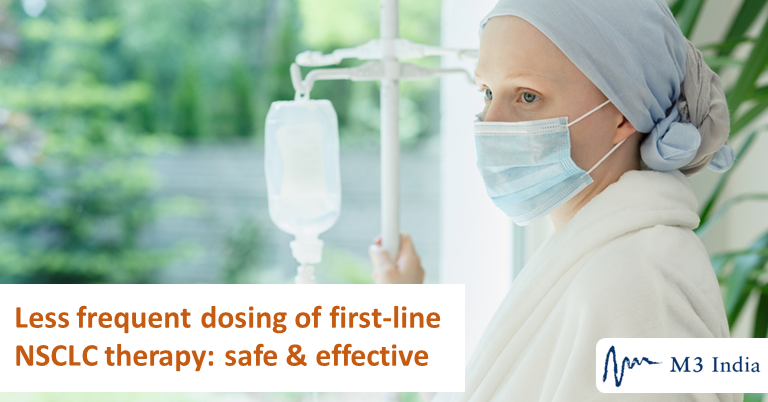Less frequent dosing of first-line NSCLC therapy found to be safe and effective
M3 Global Newsdesk May 11, 2019
Summary
- For patients with advanced NSCLC, dosing with nivolumab every 4 weeks (Q4W) instead of every 2 weeks (Q2W) is as effective and safe as second-line therapy
- Both treatment-related adverse events (TRAEs) and progression-free survival (PFS) at 6 months were similar in patients treated Q4W, researchers found

The results are from an interim analysis of the phase 3b/4 CheckMate 384 study, presented at the 2019 American Society of Clinical Oncology–Society for Immunotherapy of Cancer (ASCO–SITC) Clinical Immuno-Oncology Symposium, held in San Francisco, CA.
“Nivo[lumab] is approved as 240 mg Q2W in the [European Union] and Japan and 240 mg Q2W or 480 mg Q4W in the [United States] and Canada for second-line treatment of advanced NSCLC,” wrote the authors, led by Edward B. Garon, MD, director, Thoracic Oncology, Jonsson Comprehensive Cancer Center, University of California, Los Angeles (UCLA), Los Angeles, CA.
Safety data on the 480-mg dose are limited, and approval for this dose was based on pharmacokinetic modeling.
“Pharmacokinetic modeling in various tumors predicts that exposure, efficacy and safety can be maintained with less frequent Q4W dosing, which may provide a more convenient [treatment] option,” noted the authors.
The CheckMate 384 study is an international, open-label, randomized trial. For this interim analysis, Dr. Garon and colleagues included 329 patients from the CheckMate 384 study with previously treated NSCLC who had been treated with nivolumab for up to 12 months, and in whom disease control was demonstrated on at least two scans. Patients were randomized to receive either 240-mg doses of nivolumab Q2W (n=161), or 480 mg Q4W (n=164). They were treated until disease progression, unacceptable toxicity, or two additional years of treatment.
Co-primary endpoints were PFS at 6 and 12 months. Researchers also assessed safety.
Median PFS was similar in both groups: 12.1 months in the 480-mg group and 12.2 months in those treated with the 240-mg dose. This did not change upon subgroup analysis.
Upon safety analysis, Dr. Garon and colleagues found that TRAEs were slightly higher with the 240-mg regimen compared with the 480-mg regimen (61% vs 48%). Serious TRAEs and those leading to treatment discontinuation, however, were low in both arms (9% vs 6%, respectively). No deaths occurred in either group. Skin, endocrine, and gastrointestinal toxicities were the most common TRAEs in both groups.
“Nivo[lumab] 480 mg Q4W showed similar efficacy and safety to 240 mg Q2W in [patients] with disease control on nivo[lumab], supporting the potential use of 480 mg Q4W as a more convenient dosing option for second-line NSCLC [treatment],” they concluded.
Because patients in both groups were followed to a mean of approximately 10 months, Dr. Garon and colleagues will perform the final analysis of the CheckMate 384 trial after the total 363 patients reach a minimum follow-up of 12 months.
This story is contributed by Liz Meszaros and is a part of our Global Content Initiative, where we feature selected stories from our Global network which we believe would be most useful and informative to our doctor members.
-
Exclusive Write-ups & Webinars by KOLs
-
Daily Quiz by specialty
-
Paid Market Research Surveys
-
Case discussions, News & Journals' summaries
